

By Josh Jacquot
Photography by Josh Jacquot
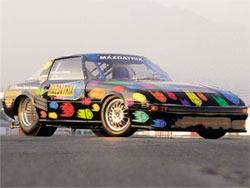 Mazdatrix owner, founder and president, Dave Lemon, hates pistons. With more than 20
years of racing rotary-powered cars under his belt, he has recently built one of the
most unique as well as one of the fastest cars in import drag racing. Dave began his
racing career in piston-powered cars but soon grew fond of the rotary after rebuilding
far too many conventional valvetrains. "I just really can't stand cylinder heads,
valves and cams," Dave said. "So I went back to the rotary, which just has a big hole
for air and fuel." That philosophy sounds simple enough to us, we checked out Dave's
one-off machine.
Mazdatrix owner, founder and president, Dave Lemon, hates pistons. With more than 20
years of racing rotary-powered cars under his belt, he has recently built one of the
most unique as well as one of the fastest cars in import drag racing. Dave began his
racing career in piston-powered cars but soon grew fond of the rotary after rebuilding
far too many conventional valvetrains. "I just really can't stand cylinder heads,
valves and cams," Dave said. "So I went back to the rotary, which just has a big hole
for air and fuel." That philosophy sounds simple enough to us, we checked out Dave's
one-off machine.
With a long history of road racing at both amateur and professional levels, this is Dave's first venture into the world of drag racing. And he's done it right. His 1,850 lb tube frame missile was designed from the ground up to be an NHRA-approved racecar. After eliminating the initial plan to build a drag car using much of the stock RX-7 chassis, the car was designed and built around its three-rotor 20B powerplant, Ford C4 automatic transmission and modified four-link rear end.
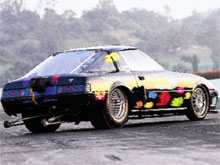 Sassy Chassis
Sassy Chassis
Construction began in December 1997 as Dave returned to motorsports after an 8-year
hiatus to get Mazdatrix on its feet. "Mazdatrix took priority when I started it in '89
and I was forced to give up racing until it was up and running as I wanted," Dave said.
After a visit to one of that year's Battle of the Imports drag races in Palmdale, Calif., Dave saw the crowds and the excitement the sport was generating and decided as a businessman he needed to build a drag car. The decision was easy after he witnessed the hundreds of competing cars and the thousands of spectators that Battle produces.
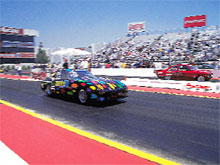 With a first generation RX-7 on hand, the crew at Mazdatrix began cutting sheetmetal,
welding subframes and generally ripping apart the original car's shell. It wasn't until
May 1998 that the plan to build a frame from the ground up was put into action. The
decision to use a full tube frame came after the crew realized how little of the original
car would be left after they finished turning it into a race car; they had already
fabricated a full cage for the car as well as located the engine and rear end. However,
with the decision to go with a full tube frame, progress on the chassis moved rapidly.
With a first generation RX-7 on hand, the crew at Mazdatrix began cutting sheetmetal,
welding subframes and generally ripping apart the original car's shell. It wasn't until
May 1998 that the plan to build a frame from the ground up was put into action. The
decision to use a full tube frame came after the crew realized how little of the original
car would be left after they finished turning it into a race car; they had already
fabricated a full cage for the car as well as located the engine and rear end. However,
with the decision to go with a full tube frame, progress on the chassis moved rapidly.
New sheetmetal was ordered from Mazda as measurements were taken from the shell that remained of the RX-7 to retain its dimensions. Lance Crain at Mazdatrix handled the TIG welding of the new chassis which was designed to fit the modified Alston four-link rear end kit. A narrowed Ford 9-inch axle was fitted to the Alston suspension. The chassis' main tubes are 1 5/8-inch mild steel while its supplemental sections are 1 1/2-inch tubing. When construction was complete and the crew was satisfied with drivetrain fitment, the entire chassis was powdercoated blue.
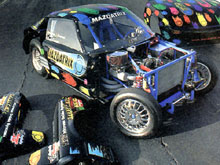 Extensive work went into making the first generation RX-7 sheetmetal fit over the
custom chassis. The Fiberglas hood, original front fenders, front cowl and airdam are
riveted and trimmed together over a light subframe that attaches to the chassis via a
series of receiver posts and quick release dzus fasteners. Used doors were lightened and
trimmed to fit the new bodywork. The rear quarter panels are removable to facilitate
removal of the rear tires. The racecar retains several original RX-7 components including
tail light lenses, door hinges (which have been extensively lightened) and a brake pedal.
It also uses front struts and brakes from a first generation GSL-SE model.
Extensive work went into making the first generation RX-7 sheetmetal fit over the
custom chassis. The Fiberglas hood, original front fenders, front cowl and airdam are
riveted and trimmed together over a light subframe that attaches to the chassis via a
series of receiver posts and quick release dzus fasteners. Used doors were lightened and
trimmed to fit the new bodywork. The rear quarter panels are removable to facilitate
removal of the rear tires. The racecar retains several original RX-7 components including
tail light lenses, door hinges (which have been extensively lightened) and a brake pedal.
It also uses front struts and brakes from a first generation GSL-SE model.
Simple Power
When asked why he selected a normally aspirated three-rotor powerplant for the car Dave's
response is simple: "Because I couldn't get a four rotor," he said. The three-rotor
nitrous injected wankel was used for its power, torque and simplicity, according to Dave.
He adds that he designed the car to be as simple as possible and a turbocharger would have
made it much more complex.
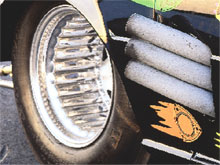 The 20B powerplant from a turbocharged Mazda Cosmo is bridge ported and has a
compression ratio of 9.0:1. The engine has also been outfitted with what Dave calls
standard race mods, which include moving the oil pick up to the back of a custom baffled
oil pan. Also among Dave's list of standard race mods is a set of headers that would make
Mad Max proud. The headers are routed from the rotary's three exhaust ports through the
tube frame and terminate Road Warrior style through the bodywork just below the passenger
door handle.
The 20B powerplant from a turbocharged Mazda Cosmo is bridge ported and has a
compression ratio of 9.0:1. The engine has also been outfitted with what Dave calls
standard race mods, which include moving the oil pick up to the back of a custom baffled
oil pan. Also among Dave's list of standard race mods is a set of headers that would make
Mad Max proud. The headers are routed from the rotary's three exhaust ports through the
tube frame and terminate Road Warrior style through the bodywork just below the passenger
door handle.
The Mazdatrix crew designed a custom intake manifold to adapt Holley's ProJection fuel system to the rotary. The 900 CFM system was originally designed for V8 applications and is capable of delivering sufficient fuel to the voracious rotary. It has adjustments for idle, choke and the accelerator pump as well as three knobs to adjust fuel mixture in the powerband's bottom, top and mid range.
The engine uses two complete nitrous assemblies from Nitrous Oxide Systems, Costa Mesa, Calif. Nitrous oxide is delivered via two programmable timers activated at full throttle by the engine's throttle position sensor. Foggers are ported directly into each of the Intake manifold's six ports. Programmable timers allow for adjustment of delay time between application of full throttle and nitrous activation, which gives the system tremendous flexibility and adjustability, according to Dave. Also adjustable is the percentage of nitrous initially delivered and build time to final percentage on each system. This allows for full control over the engine's output while running on the bottle.
Dave used a 12A distributor, which is modified by Racing Beat for racing applications. Spark is controlled by two MSD 7AL ignition controllers and two Mallory coils. MSD's multi-step retard units work in conjunction with a J&S knock sensor, which was modified for use on the three-rotor to retard timing upon activation of the nitrous systems.
Dave estimates the 20B produces about 400 hp when it's not using either of the 200-hp nitrous systems. "We designed the car for versatility and adjustability," Dave said. "This increases the development time but gives a better final result."
Also unique to the car is Dave's choice of transmissions. He decided early in the project that he wanted to use an automatic to reduce the shock to the drivetrain on launches. He used Ford's C4 automatic Mustang transmission, which transmits torque to the Ford 9-inch rear end through a custom built 18-inch driveshaft. A Detroit locker differential handles traction duties. Dave uses a 6500 rpm stall speed torque converter to keep the car from bogging off the line.
The car's entire build up with pictures and narratives is documented online at www.mazdatrix.com. The car was built as a marketing tool to demonstrate the company's capabilities and uses many parts available from Mazdatrix. In fact, Dave has plans in the near future to design and begin selling custom Nitrous kits for first, second and third generation RX-7s.
In it first outing the RX-7 made a best run of 9.8@135mph at Los Angeles Country Raceway in Palmdale, Calif. This run was made using only one of the car's nitrous systems at less than full capacity. We suspect once Dave and the rest of the Mazdatrix crew get the car fully dialed in, 8-second runs aren't out of the question. Running at that speed Mad Max wouldn't even be able to keep up.

[Mail me] [To Lightning home] [To my home page] [Copyright Notice]